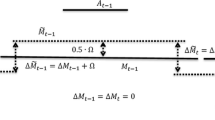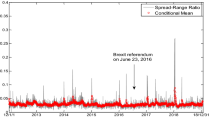Abstract
This study examines the risk-compensating behavior of REIT market makers. The bid-ask spread is hypothesized to compensate market makers for three costs: asymmetric information, order processing, and inventory. As the market maker's perceived likelihood of transacting with a better-informed individual increases (decreases), the percentage of the spread that is attributed to asymmetric information will increase (decrease). This study examines the asymmetric information component of the bid-ask spread immediately prior to and following REIT dividend announcements and REIT funds from operations announcements during 1995 and 1996. The asymmetric information component increases the day before and then declines subsequent to dividend announcements of small and equity REITs. Asymmetric information costs increase following funds from operations announcements.
Similar content being viewed by others
References
Below, S. D., J. K. Kiely, and W. McIntosh. (1995). “An Examination of Informed Traders and the Market Microstructure of Real Estate Investment Trusts,” Journal of Real Estate Research 10, 335-361.
Below, S. D., J. K. Kiely, and W. McIntosh. (1996). “REIT Pricing Ef®ciency: Should Investors Still Be Concerned?” Journal of Real Estate Research 12, 397-412.
Bhasin, V., R. A. Cole, and J. K. Kiely. (1997). “Changes in REIT Liquidity 1990±94: Evidence from Intra-day Transactions,” Real Estate Economics 25 (Winter), 615-630.
Brooks, R. (1994). “Bid-Ask Spread Components Around Anticipated Announcements,” Journal of Financial Research 17 (Fall), 375-386.
Conrad, J., and C. M. Niden. (1992). “Order Flow, Trading Costs and Corporate Acquisition Announcements,” Financial Management 21 (Winter), 22-31.
Copeland T. E., and D. Galai. (1983). “Information Effects of the Bid-Ask Spread,” Journal of Finance 38, 1457-1469.
Downs, D. H., and Z. N. Guner. (1998). Is the Information Deficiency in Real Estate Evident in Public Market Trading? Working paper, University of Georgia.
Easley, D., and M. O'Hara. (1987). “Price, Trade Size, and Information in Securities Markets,” Journal of Financial Economics 19, 69-90.
Ghosh, C., M. Miles, and C. F. Sirmans. (1996). “Are REITs Stocks?” Real Estate Finance 13 (Fall), 46-53.
Glascock, J. L., W. T. Hughes Jr., and S. B. Varshney. (1998). “Analysis of REIT IPOs Using a Market Microstructure Approach: Anomalous Behavior or Asset Structure,” Journal of Real Estate Finance and Economics 16 (May), 243-256.
Glosten, L. R., and P. R. Milgrom. (1985). “Bid, Ask and Transaction Prices in a Specialist Market with Heterogeneously Informed Traders,” Journal of Financial Economics 14, 71-100.
Huang, R. D., and H. R. Stoll. (1994). “Market Microstructure and Stock Return Predictions,” Review of Financial Studies 7 (Spring), 179-213.
Huang, R. D., and H. R. Stoll. (1997). “The Components of the Bid-Ask Spread: A General Approach,” Review of Financial Studies 10 (Winter), 995-1034.
Kim, O., and R. E. Verrecchia. (1994). “Market Liquidity and Volume Around Earnings Announcements,” Journal of Accounting and Economics 17 (January), 41-67.
Lin, J. C., G. C. Sanger, and G. G. Booth. (1995). “Trade Size and Components of the Bid-Ask Spread,” Review of Financial Studies 8 (Winter), 1153-1183.
Mann, S. V., C. G. McDonald, and P. Ramanlal. (1998). The Impact of the Assumed Order Arrival Process on the Bid-Ask Spread's Cost Components. Working paper, University of South Carolina.
Myer, F. C. N., and J. R. Webb. (1993). “Return Properties of Equity REITs, Common Stocks, and Commercial Real Estate: A Comparison,” Journal of Real Estate Research 8 (Winter), 87-106.
Stoll, H. R. (1989). “Inferring the Components of the Bid-Ask Spread: Theory and Empirical Tests,” Journal of Finance 44, 115-134.
Wang, K., J. Erickson, and G. W. Gau. (1993). “Dividend Policies and Dividend Announcement Effects for Real Estate Investment Trusts,” Journal of the American Real Estate and Urban Economics Association 21 (Summer), 185-201.
Wang, K., J. Erickson, G. W. Gau, and S. H. Chan. (1995). “Market Microstructure and Real Estate Returns,” Real Estate Economics 23 (Spring), 85-100.
Wei, P., C. Hsieh, and C. F. Sirmans. (1995). “Captive Financing Arrangements and Information Asymmetry: The Case of REITs,” Real Estate Economics 23 (Fall), 385-394.
Author information
Authors and Affiliations
Rights and permissions
About this article
Cite this article
McDonald, C.G., Nixon, T.D. & Slawson, V.C. The Changing Asymmetric Information Component of REIT Spreads: A Study of Anticipated Announcements. The Journal of Real Estate Finance and Economics 20, 195–210 (2000). https://doi.org/10.1023/A:1007829405545
Issue Date:
DOI: https://doi.org/10.1023/A:1007829405545




